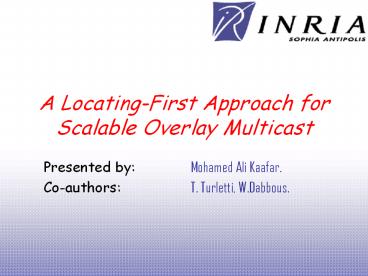A LocatingFirst Approach for Scalable Overlay Multicast PowerPoint PPT Presentation
1 / 28
Title: A LocatingFirst Approach for Scalable Overlay Multicast
1
A Locating-First Approach for Scalable Overlay
Multicast
- Presented by Mohamed Ali Kaafar.
- Co-authors T. Turletti, W.Dabbous.
2
Outline
- Background and motivations
- LCC overview
- The locating process
- Clustering
- Experiments results
- Conclusions
3
Application Layer Multicast (ALM)
- Relies on end systems only
- Pros
- Ease of deployment
- Cons
- Lower bandwidth efficiency and higher end-to-end
delay - Heavy control overhead
- Challenges for large groups
4
Why is self-organization hard?
- Dynamic changes in group membership
- Members join and leave dynamically, fail
- Limited knowledge of network conditions
- Members do not know delay to each other when they
join - Overlay must self-improve as more information
available - Dynamic changes in network conditions
- Delay between members may vary over time due to
congestion
5
What is LCC?
- Locating-First Underlying Topology-aware
- Practical No landmarks, no virtual coordinates
systems, - Clustering hierarchical approach
6
LCC, QoS aspects enhancements?
- Scalability Less refinement procedures,
- Reduce management overhead and delivery tree
changes. - Efficiency Shorter convergence time.
- Tradeoff Locating Overhead messages/time.
7
The locating process
d(L,n)
d(L,k)
L
n
k
Level 1
Level 2
Level 3
- A set of non overlapping and exponentially
increasing levels, represented by intervals - ri, ri1, where ri Alpha ei-1 for i gt 1 and
r0 0
8
Locating scenario, Request
Newcomer
d(L,n)
Boot node
Queried nodes
Level 1
Level 2
Level 3
9
Locating scenario (contd)
- Queried nodes answers are filtered
- Only queried nodes whose distances to n are less
than d(L,n) are selected. - List of candidates
- The first ranked node is the next requested node
- Recursively repeat the request procedure.
- The list is updated at each request.
10
Selective Locating process
Level 1
Level 2
Level 3
S.A 5
S.A 4
S.A 3
S.A 2
S.A 1
S.A i /
Newcomer
Requested node
Representative node
11
Clustering process
- If locating ends with no cluster leader in scope
(Rmax), - create new cluster,
- Else join one or a few others.
- Clusters define the top-level links,
- If cluster leader
- Or Edge node !
12
LCC architecture
Top-level Delivery Tree
Rmax
Cluster Leader
Edge Node
Top-level Link
Intra-Cluster Link
Cluster member
13
Clustering
- Define Priority vectors (PV) used to maintain a
nodes rank. - PV lt fmax 1/DL T 1/CLMigrated gt
- Shared local cache, to construct a proactive
rescue plan. Eligible nodes in a cluster are
sorted in the local cache.
14
Clustering
- Network or membership changes recovery
- Recursive Recovering algorithm to detect and
repair migration. - A potential leader node asks subsequent nodes in
the cache to join its cluster, - And triggers a recovering procedure for migrated
nodes that are not in its scope.
15
Performance Evaluation
- Linux distribution, wrappers for vic, rat, vlc
(under test). - http//www-sop.inria.fr/planete/software
- Particular real-world experimentations
PlanetLab. - 212 nodes.
- Simulations Scalability
- 2000.. 10000 overlay nodes.
- Comparison
- OMNI (Overlay routers)
- ZigZag (Hierarchical)
- Flat MeshTree
16
Metrics
- Scalability,
- Control overhead during data distribution
- Control overhead during overlay joining
- Link Adjustment Rate
- Efficiency,
- Convergence Time
17
(Sim) Overhead
18
(PL) Locating Overhead
19
(Sim) Adjustment Rate
20
ARDP
- Average Relative Delay Penalty
- 1/(N-1) . ?(i1, N-1) d(s,i) / d(s,i)
- Incurred delay due to overlay
21
(Sim-PL) Convergence Time
22
Conclusions
- Practical Scalable overlay Multicast scheme.
- Not too much overhead while locating first.
- Better adaptability to underlying nw changes.
- ALM is not only for small groups ?
- LCC is very suitable for large scale applications.
23
What next?
- Automatically tune nodes scopes, stop criterion,
- More real life tests.
- What about Intermittent connectivity networks
(DTN),?
24
Annexes
25
(Sim) ARDP
Zoom
26
(Sim) Protocol Robustness
27
(PL-Sim) Locating Accuracy
28
(PL-Sim) Locating Accuracy

